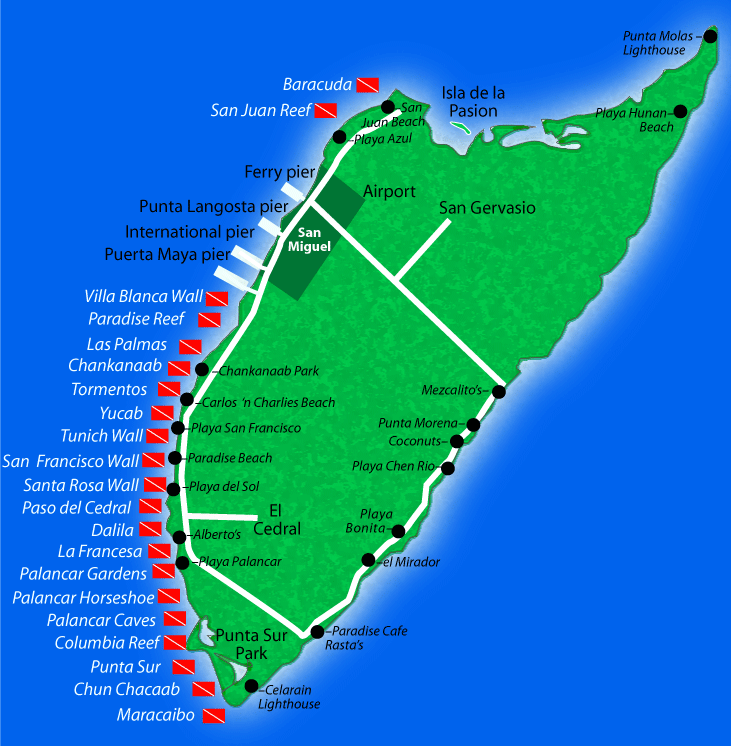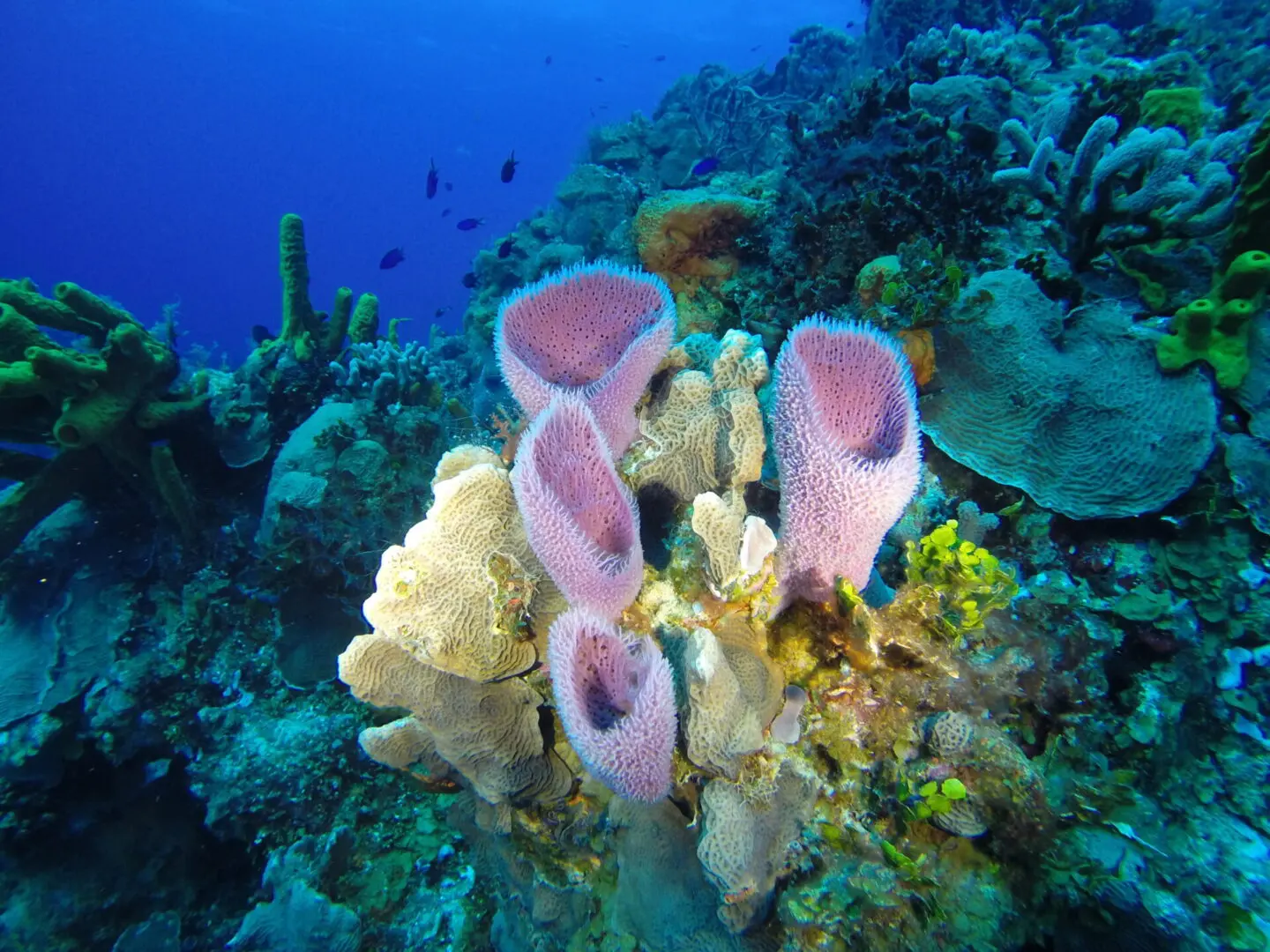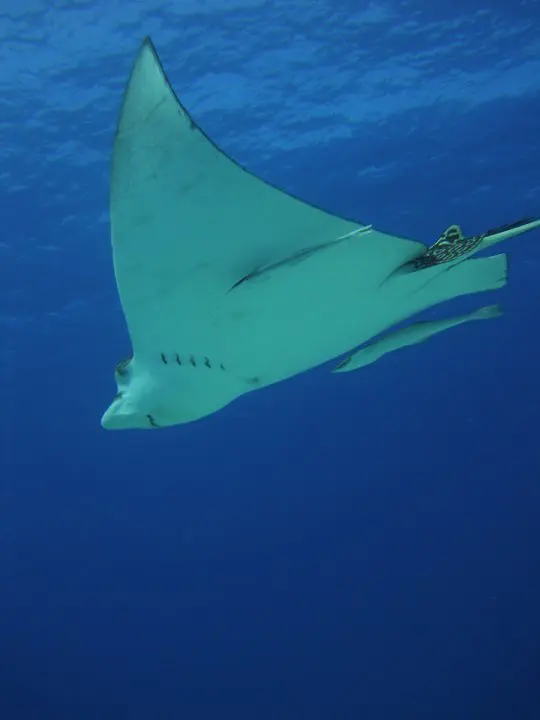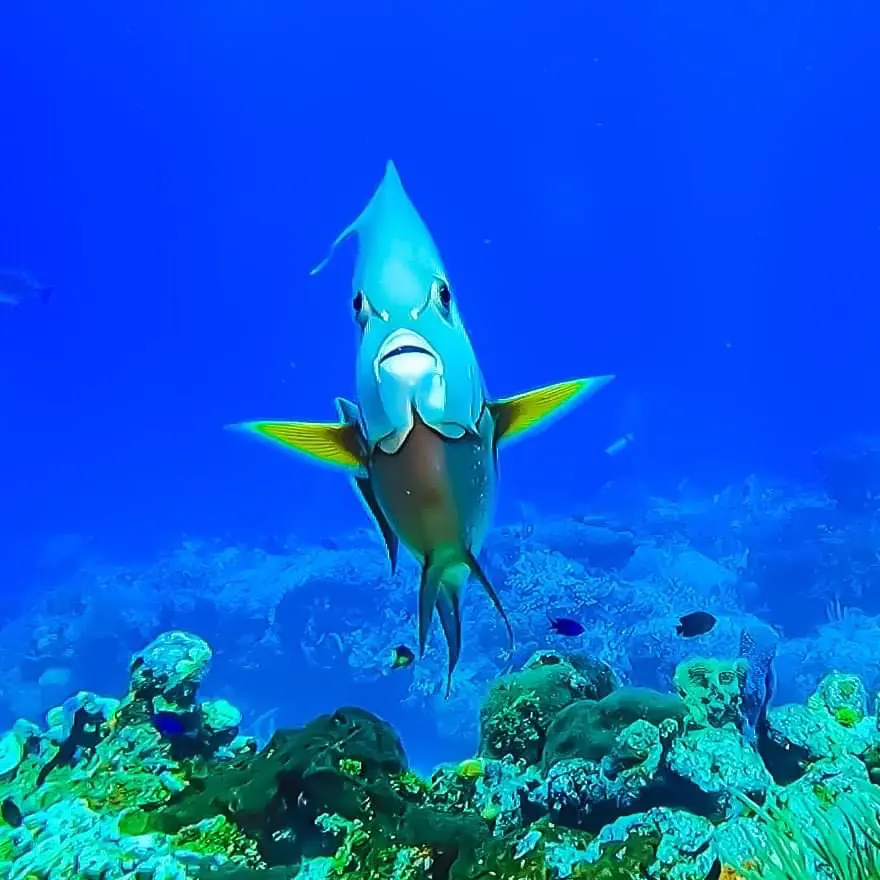Dive Sites of Cozumel
>>BARRACUDA AND SAN JUAN REEFS (45'-100')
Most of the dive operators rarely visit JUAN reefs and BARRACUDA reefs and require prior authorization from the Harbor Master to dive. The current here is very strong and can be unpredictable and dangerous. That said, the advanced diver may be rewarded with sightings of large Pelagics, including Eagle Rays and Sharks!
>>VILLA BLANCA WALL (50'-100')
The Villa Blanca Wall is the closest reef south of San Miguel. The dive begins at about 50' and continues down to 100'. Along the way, you will see a sloping wall covered with giant sponges and gorgonians and generally considered a boat dive. However, experienced divers can access it directly from the beach.


>>PARADISE REEF (40'-50')
This is one of the best places to spot the elusive “splendid toadfish” FOUND NOWHERE ELSE IN THE WORLD, except Cozumel. Paradise is an excellent beginning or refresher dive. Dive at Paradise Reef at night to see giant crabs, eels, and octopuses.
>>LAS PALMAS (40'-50')
Las Palmas is a beautiful steep slope dropping off from the top of the Reef at 40-50 ft into the depths. The Reef is decorated with sponges, small coral heads, gorgonians, and soft coral that provide a rich habitat for an immense quantity of marine life.
CHANKANAAB (40'-80')
>>CHANKANAAB REEF (40'-50')
This is the only Reef where the current generally runs from North to South. The dive begins over a flat sandy area with a series of coral heads, home to king crab, spotted moray eels, and many substantial spiny lobsters. To the southern colonies of soft corals, sea whip, and gorgonians give shelter to grouper while they visit cleaning stations staffed by gobies and cleaner shrimp.
>>CHANKANAAB BOLONES (60'-80')
Is a relatively flat sandy bottom ranging from 60 to 80 ft in depth. Two types of coral heads dot the seabed with smaller formations in the shallows and large ones in the deep. The abundance of life and the amount of different types of coral is stunning. Various spotted moray eels inhabit the Reef, as well as plenty of lobster, king crabs, and an enormous variety of small, colorful reef fish. Eagle rays are also spotted here very often.


>>C-53 (Felipe Xicotencalt or The Wreck) (50'-60')
The C-53, or “Felipe Xicotencalt,” was sunk on June 5th, 2000, to create an artificial reef for scuba divers in Cozumel. The dive plan is usually 45 minutes of bottom time, and once you penetrate the wreck, your average depth is around 50-60 feet. The maximum amount of divers per divemaster is four. Even with its relatively short period of time submerged, the wreck already serves as a shelter for several species of marine creatures, including schools of glassy sweepers, grunts, and lobsters. It is strongly recommended that divers wear a wet suit or skin and gloves for protection. Also, it is recommended that divers have a dive light.
>>TORMENTOS (50'-60')
Tormentors offer some of the best photo opportunities in Cozumel. Drift back and forth and between the coral heads to discover a new site around each one. Many giant grouper abide here. All eels are found in the crevices and holes, along with schools of fish around many of the ledges.
>>YUCAB (50'-60')
Drifting with the current, you will reach a denser type of coral which forms the central part of the Reef. The Reef is full of a wide selection of marine life. The outer edge and the sand-scoured overhangs offer shelter from the current, giving photographers and divers the chance to appreciate the fantastic variety of marine life. Octopus, scorpionfish, lobster, and the splendid toadfish, endemic to the island, can be seen here. The coral strip in the Northernmost part of the Reef is divided by white channels of sand, providing other routes for divers to explore.
>>PUNTA TUNICH
The current at Punta Tunich allows you to fly over this underwater garden. In this area, you will see many sea fans and whips. Look for the two famous green eels and nurse sharks. Depending upon the season, eagle rays or turtles may be seen.
>>SAN FRANCISCO WALL
The dive starts on a sandy patch inside the wall blanketed with colorful sponges and sea fans. Blue chromic and bicolor fish cover the Reef’s crest, while schools of grunts shelter under the overhangs; turtles, eagle rays, nurse sharks, and even the occasional blacktip reef shark cruise along the wall. Drifting North, an area of dense coral growth will captivate you with its impressive marine life and will lead you toward a shallower plateau dotted with individual coral heads. Before beginning your ascent, look for a vast, green moray eel that inhabits this northernmost section.
>>SANTA ROSA WALL
Santa Rosa is a classic Cozumel wall and one of the most popular. You glide along this enchanting wall at 80 ft suspended over the deep blue. While gliding along the wall, you can swim in and out of the tunnels. Large groupers accompany you on your journey past the giant sponges of the Santa Rosa wall.
>>PASO DEL CEDRAL
Fly along this carpeted Reef while being circled along your way by the huge friendly grouper. The current here provides a brisk ride. The famous green eel of Paso del Cedral occasionally joins you for a swim alongside. The swim-through tunnels with the sun beaming through from overhead help to make this reef even more fun. While the corals here remain small, the marine life and current make it one of our most exciting dives.
>> DALILA
You will find yourself drifting over a green carpet of sea plants and lower coral formations, covering the reef that rises 30 feet from the bottom. This area is known for its variety of fish and is a true adventure as you never know what will hide in the reef. Maybe you will find yourself swimming along with a nurse shark or a turtle before they take off and seek a new hiding place.
>>LA FRANCESCA
This relatively shallow dive is suitable for all divers. It’s an excellent choice for a very colorful second tank dive. Descending to the reef crest, you will find a thriving coral community, home to many splendid toadfish, pipe horses, and large-but-docile nurse sharks. Innumerable tunnels, swim-throughs, and crevices cut through the Reef, harboring a fantastic variety of marine life. Eagle and stingrays hang on the fringes of the reef, feeding on morsels hidden in the sand. The reef is abundant with flower and cup corals which grow here in enormous colonies which are particularly beautiful.
PALANCAR
>>PALANCAR GARDENS
Here the marine life may not be as abundant as in other sections of Palancar. However, it is a richly colored dive with lots of angels, butterflies, and tangs, just to name a few. The lavender-colored vase sponges are everywhere while the whips sway along with the mild current. Photography is excellent on this section of Palancar Reef.
>>PALANCAR HORSESHOE
Towers of the brain, star, and sheet coral heads protrude within 20 feet of the surface. Excellent dive spot.
>>PALANCAR CAVES
Come and dive into the room-sized caves and tunnels of the world-famous Palancar Reef. Black coral and colorful sponges are to be found growing in the depths here. The sheer size of the coral formations is incredible. When on the wall, be sure to look up to see the enormity of Palancar's mountains.
>>PALANCAR BRICKS
This particular section of the Palancar Reef is the Southernmost part close to Colombia Reef. It is easily recognized by its brick formations covered with coral. An almost vertical drop into the abyss starts this dive that slowly builds up to large coral columns as you drift further North. There is a good chance of catching a glimpse of a spotted eagle ray or a stingray in this area.
COLOMBIA
>>COLOMBIA WALL
Explore the depths through the tunnels of Colombia while drifting along the wall edge. Drift through the tremendous coral heads beginning from 60 to 100 feet and more to reach within 30 feet of the surface. Swim through the schools of glassy sweepers residing here in the deep. Depending on the season here, you may find turtles (summer) and eagle rays (winter).
>>COLOMBIA SHALLOW
This shallow reef (25 feet to 30 feet maximum) is a paradise for snorkelers and divers alike looking for lots of bottom time. While the coral formations here are small, there is abundant marine life. A good choice for divers looking for an easy, shallow dive without a lot of currents. This reef is an excellent 2nd dive because no surface time between dives is required. This reef is a photographer's paradise.
PUNTA SUR
>>PUNTA SUR
(Special Dive) Punta Sur is an impressive, deep wall dive on the Southern End of the island. This dive will take you through “Devil’s Throat,” a narrow tunnel lined with red sponges located inside this area’s most giant coral mound. Descending onto a sandy area at 60 ft, you will make your way from there down to a huge coral mound at 120 to 130 feet and enter a large cave that leads to a small cavern. Here you will angle up and exit back at 60 feet. The dive is an unforgettable experience! Good buoyancy is essential.
>>PUNTA SUR CATHEDRAL
(Special Dive) A dive here begins on a sandy ridge inside the wall at 70 ft. Moving out to the edge of the wall, you will find a mound of large coral structures that reach from 45 feet down to a depth of 100 ft or more. Traveling north, you will arrive at the "Cathedral," a large cavern with a vaulted ceiling. Shimmering streaks of sunlight filter in through cracks and crevices, and a bright blue oval window penetrates the darkness ahead of you. The “Cathedral” has multiple openings, making it easy to move through, and it is one of the most impressive caverns on the island.
MARACAIBO
>>MARACAIBO WALL
(Special Dive) The vertical drop-off and the chance of spotting large animals make Maracaibo Wall one of Cozumel’s most dramatic wall dives. Located at the Southernmost reef, the boat ride is long, and divers should expect large ocean swells when entering the water. With the big blue on three sides and a colorful wall on the other, this dive is only for experienced divers. The wall here is laden with all colors and types of sponges and deep water gorgonians. Here you may drift along with turtles, eagle rays, and an occasional shark.
>>MARACAIBO SHALLOWS
This 70 to 80 feet Reef is located off the lighthouse on the island's southeast side. Divers rarely visit it, and here you have a good chance of seeing turtles, rays, and nurse sharks. The marine life is abundant with many different species of coral, which are different from the coral formations found along the west side of the island.
